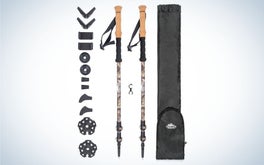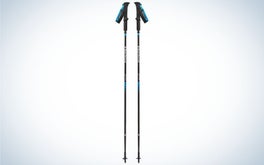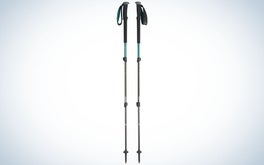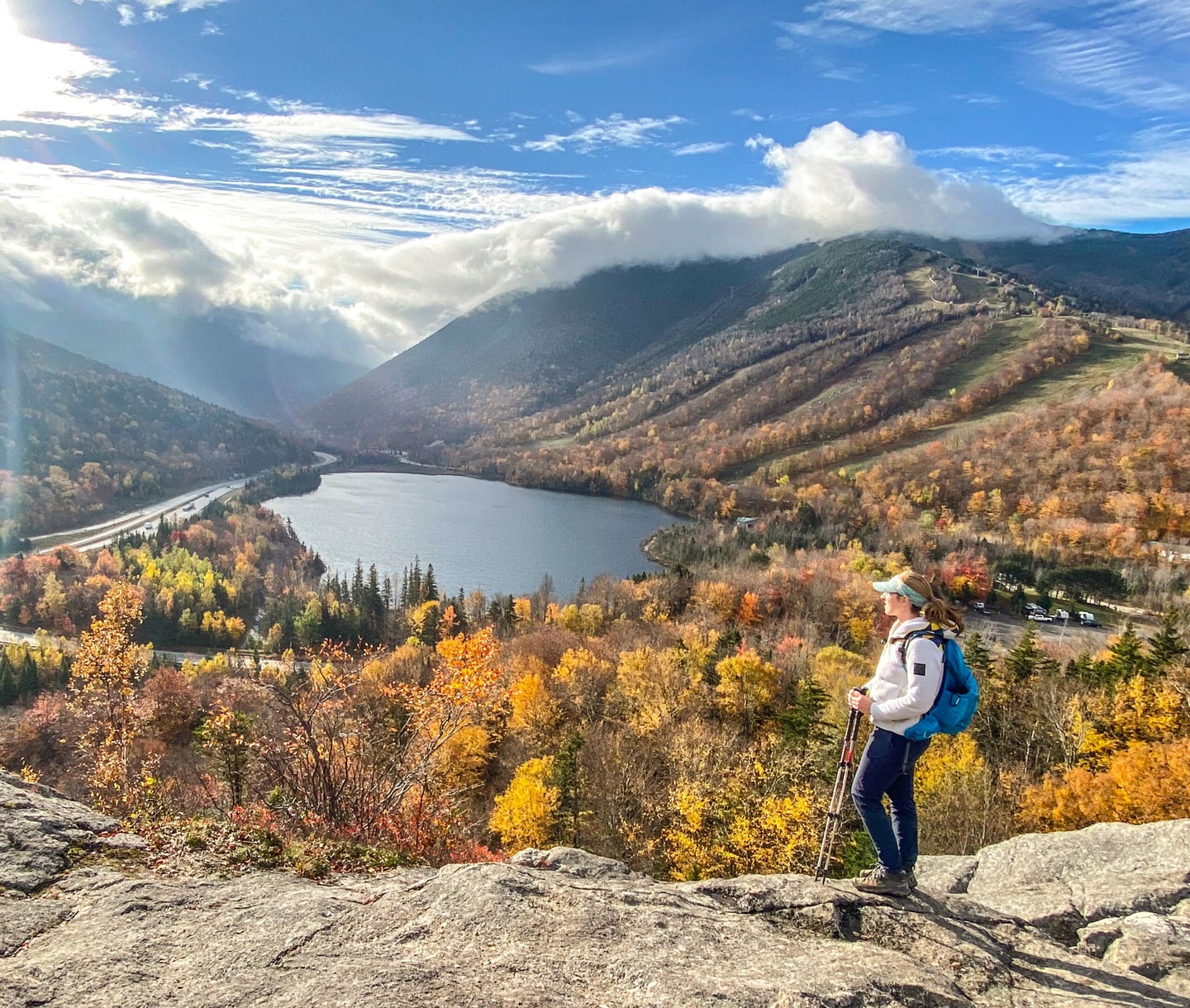| Best for Hunting |

|
Cascade Mountain Mountain Tech Carbon Fiber | SEE IT |
LEARN MORE
|
Summary
These fully adjustable trekking poles come with a variety of accessories, including a rifle mount. Plus, they come wrapped in a Mossy Oak pattern. |
| Best Ultralight |

|
Black Diamond Distance Carbon Z | SEE IT |
LEARN MORE
|
Summary
These poles are a favorite for thru hikers, ultralight hikers, trail runners, and travelers—anyone looking to shave every possible ounce. |
| Best Shock-Absorbing |

|
Black Diamond Trail Pro Shock | SEE IT |
LEARN MORE
|
Summary
These are a durable and comfortable trekking pole perfect for everyday hiking, with a shock absorbing feature that really makes a difference when navigating rough terrain or carrying a heavy load. |
We may earn revenue from the products available on this page and participate in affiliate programs. Learn more ›
Trekking poles—or walking sticks, as some people call them—allow you to cover distance on foot with lower impact on your knees and feet while improving balance and stability. While some people might see them as a nuisance, the adoption of trekking poles by skilled hikers has shown that there are real advantages to their use.
Gone are the times when you could rely on a tall wooden staff as your only option for support. The market is flooded with various pole types, materials, accessories, and price points that can overwhelm the buyer. Here’s how to choose the best trekking poles for any adventure.
- Best for Hunting: Cascade Mountain Tech Carbon Fiber Monopod (in Mossy Oak)
- Best for Men and Women: Leki Micro Vario Carbon Men’s and Women’s Trekking Poles
- Best Budget: MSR DynaLock Trail Backcountry Poles
- Best Ultralight: Black Diamond Distance Carbon Z
- Best Shock-Absorbing: Black Diamond Trail Pro Shock Men’s and Women’s
How We Picked the Best Trekking Poles
My first experience hiking with poles was a day hike to the bottom of the Grand Canyon back in 2007. I brought my ski poles to help my recently injured knee manage the trip. Since then, I’ve been using them consistently for hiking, snowshoeing, skiing, backpacking, and wilderness exploration. I’ve found trekking poles to be an essential piece of gear that can provide stability, increase my stamina, and transfer work from my legs to my arms and shoulders.

As a backpacking guide in the White Mountains in the 2010s, I went through multiple pairs of poles—seeing them snap, break, and parts pop off. The older designs often had a twist-lock mechanism for an adjustment that, with frequent use, suffered from a stripped screw rendering the poles utterly useless in the field.
I’ve watched the technology and market for trekking poles explode in the last 10 years with lighter weight carbon poles, stronger locking mechanisms, and accessories galore. There really is the perfect pole for every person. When trying out trekking poles for this article, I based my choices on the following characteristics:
- Utility: I asked myself, “Does this tool do what it’s intended?” Where a day hiker will want a lightweight and comfortable set like the Leki Micro Vario Carbon, a backcountry skier would find them too fragile against the snow and ice of winter. Therefore, I looked for poles that fulfill their role well.
- Value: Trekking pole prices range from $20 to $300. The question is, “Is it worth the price?” As someone using their trekking poles weekly and over varied terrain and seasons, a pricier pole by Leki or Black Diamond is worth it for the added comfort, weight, durability, and quality. However, if you’re looking for a pole you can pull out a couple times a year and get a good value, Cascade Mountain Tech will provide a quality pole that will fit your periodic needs.
- Quality: As someone who has had many poles fail me in the past, I’ve discovered the importance of a quality pole. Not only does the pole need to be resistant to snapping, but the handle, locking mechanism, tips, and straps all need to be durable enough to handle frequent use and the outdoor elements.
Other factors to consider when shopping for a pair of trekking poles include weight, material, length, and packability. But since the preferred outcome depends on the activity, they can’t be used as a unit to cross compare designs.
For my personal use, I have several sets of trekking poles. My go-to is an older set of aluminum shock-absorbing poles similar to the Black Diamond Trail Pro Shock. I like that they are durable and comfortable, and the shock absorbing helps with mountain descents, which is where I need the most support.
Best Trekking Poles: Reviews & Recommendations
Best for Hunting: Cascade Mountain Tech Carbon Fiber Monopod (in Mossy Oak)
Specs
- Material: Carbon fiber
- Weight (Two Poles): 1 lb 3.2 oz
- Extended Length: 28.5 – 60″
Pros
- Fully adjustable for all heights with easy-to-use external lever locks
- Accessories include a gun rest, camera mount, phone mount, mud baskets, snow baskets, and rubber tips
- Comes as a monopod (singular trekking pole) or a trekking pole pair
Cons
- Doesn’t pack down small enough to fit inside a backpack
- Grip handle sacrifices ergonomics for convenience of mounted accessories
Cascade Mountain Tech’s Carbon Fiber Monopod are not only the best trekking poles for hunters but for outdoors folk with a myriad of interests. Although this is also sold as a monopod (single trekking pole), I tested this design as a pair. From the start, I was impressed with the accessories. This is a pole that you could take out in all terrains and weather. The versatility of adding snow baskets means they can be used for skiing/snowshoeing, and the external locking mechanism is easy to use, even with gloves on.
For hunters and photographers, the top of the cork hand grip screws off to expose a ¼-20 threaded stud. There, you can attach a V-shaped shooting rest, smartphone mount (both included), or screw in a large camera. In addition to the top mounting accessories, the pole also comes with two separate styles of rubber tips—perfect for pavement and soft rock.
While all these bonus features are dazzling, it’s important to remember these add weight to the pole and affect the design. I found that after a long and challenging hike, I would have preferred an ergonomic hand grip to the disjointed screw-top one. It also doesn’t pack down small enough to fit in a backpack and will have to be strapped to the exterior if not in use.
Carbon fiber poles like these usually cost upwards of $100, yet this carbon pole and accessory pack is only $39.99 for one and $69.99 for the pair—giving this set another award for Best Value Trekking Pole.
Best for Men and Women: Leki Micro Vario Carbon Men’s And Women’s Trekking Poles
Specs
- Material: Carbon fiber
- Weight (Two Poles): Men’s: 1 lb, 1 oz; Women’s: 1 lb
- Extended Length: Men’s: 43 – 51″; Women’s, 39 – 47″
Pros
- Packs small with Z-folding design
- Gender-specific poles offer differences in hand grip size, weight, and length
- Adjustable lengths sized for average heights of both sexes
Cons
- Costly
From the graceful folding system to the ergonomic hand grips, and the sleek yet sturdy latching system, it’s clear the Leki Micro Vario Carbon is a quality trekking pole. Leki’s offering of a men’s and women’s version shows the careful thought put into their designs. The gender-specific models offer differences in hand grip size and length for a better fit.
The Leki Micro Vario Carbon falls into the category of ultralight trekking pole – often preferred by backpackers, travelers, and trail runners. Although this pole isn’t the lightest in this category, it’s one of the few that offers adjustable length. I find this especially useful since I lengthen my poles for downhill treks and shorten them when going uphill.
Although lightweight, the Leki Micro Vario Carbon is still sturdy and durable. Kevlar-reinforced tension cord connects the pole sections, and the main locking mechanism is internal and protected. Lastly, I appreciated the adjustable wrist strap. Putting pressure against this can help sturdy the user, and a soft, adjustable strap makes it more comfortable.
These pole’s ability to pack down extremely small (only 16 inches long) is a huge draw. The tiny size makes them easy to bring along just in case you run into technical terrain on a hike or pack in your luggage for an adventure away.
All this design comes at a price, and while there’s no doubt the Leki Micro Vario Carbon is one of the best trekking poles for men and women on the market, it also has one of the highest price tags.
Best Budget: MSR DynaLock Trail Backcountry Poles
Specs
- Material: Aluminum
- Weight (Two Poles): 1 lb 5 oz
- Extended Length: 39.5 – 55″
Pros
- Affordable
- Adjustable
- Strong aluminum shaft
Cons
- Not lightweight
- Does not pack small enough to put into a backpack
MSR’s DynaLock™ Trail Backcountry poles are the best budget trekking poles designed specifically for winter sports. The large snow baskets help prevent the pole from sinking into deep powder as you traverse snowy ground. They also come with a set of small mud baskets to use when hiking, which extends their use to warmer months.
The pole adjusts to a large range of lengths and clicks into place securely with the DynaLock™ clasping feature. The aluminum construction means it’s on the heavier side but allows this pole to take more of a beating than its carbon counterparts.
With a price point of around $60, this is one of the most affordable trekking poles around and definitely the most affordable in the backcountry category. The handles are made of hard plastic in a kind of old-school ski pole grip with a polyester wrist strap. These poles are not fancy or flashy, but will get the job done with your best snowshoes or skis, and can second as a pair of hiking poles.
Best Ultralight: Black Diamond Distance Carbon Z
Specs
- Material: Carbon
- Weight (Two Poles): 10.4 oz
- Extended Length: 39 – 51″
Pros
- Ultralight
- Durable
- Packs down to 13-17 inches (depending on size) with a Z-folding design
Cons
- Not adjustable
As the best ultralight trekking poles, the Black Diamond’s ultralight Distance Carbon Z trekking poles pack small and have a total weight of less than a pound. Built with a 100% carbon fiber shaft, the pole folds (Z-style) to just over a foot to stash just about anywhere. You probably won’t even notice them tucked into your pack.
Even though it’s lightweight, these poles are durable for their class. While you shouldn’t smack them into rocks, they feel sturdy on rough ascents and scrambles.
To save weight, the hand grips are made from foam with cutouts. It also has lightweight straps that aren’t cushioned, but are still soft to the touch. Combined, they provide excellent suspension that helps keep shock loads off your knees.
While this trekking pole takes the cake in mastering ultralight, it’s not the right choice for those looking for an adjustable pole. Instead, buyers purchase a one-length pole based on their height. This might be frustrating if you like to adjust the height based on terrain or share your poles with others.
Best Shock-Absorbing: Black Diamond Trail Pro Shock Men’s and Women’s
Specs
- Material: Aluminum
- Weight (Two Poles): 1 lb 2.8 oz
- Extended Length: Men’s: 41 – 55″; Women’s, 37 – 49″
Pros
- Shock-absorbing
- Durable locking mechanism
- Comfortable wrist straps
Cons
- Does not pack down small enough to put into a backpack
The shock absorbing ability of the pole on the Black Diamond Trail Pro Shock is second to none. A small internal compression mechanism is built into the pole just below the handle. I find this especially useful and comfortable when carrying a heavy load and maneuvering over hills on rough terrain. With most of my mountain hiking over the rocky mountains of New Hampshire, this is one of my favorite features in a trekking pole.
This is also a great choice for someone who needs a pole that will take a beating. The aluminum frame is durable enough to toss the poles to the ground on a water break and get smashed against rocks. I’m also a fan of the thick comfortable wrist straps.
The Black Diamond Trail Pro Shock comes in men’s and women’s models, with the men’s extending longer and having a slightly larger hand grip. Both models allow the user to adjust the length with an easy-to-use locking system.
If looking for a lightweight and packable pole, this isn’t the one for you. It only packs down to 27 inches and is one of the heavier models on the market.
What to Consider When Choosing Trekking Poles
It can be overwhelming trying to navigate the world of trekking poles. There many different designs, tailored for an assortment of activities and body types. And the list of materials used in their construction is extensive and varied. Here are three things to consider before buying trekking poles:

Quality
The quality of trekking poles vary by price point. If you are planning on using these tools frequently and over many years, it’s worth the cost to invest in a high-quality pair. Similarly, if you are going to be trekking in extreme weather and/or over long distances, it’s worth the investment for an activity-specific pair. Just trying them out? It’s ok to sacrifice the higher quality features until you are ready to invest. Here’s what to consider for quality:
- Material: Carbon is more expensive than aluminum but also generally lighter. Aluminum is less expensive but more durable.
- Ergonomics: Higher quality poles have comfortable, ergonomic handles that contour to the hand.
- Shock absorbing: Spring-loaded shock absorbers built into the pole will help absorb impact but also come with a higher price tag.
- Weight: Ultralight and packable poles are preferred by backpackers and trail runners.
Activity
Before purchasing trekking poles, consider the activity you plan to use them for. Do you really need an ultralight trekking pole? Or would a little more weight be fine in order to have more comfortable wrist straps and adjustment features. Here’s what to look for based on activity:
- Backpacking: ultralight pole that collapses to fit in your pack
- Hunting and/or photography: attachments for camera or gun rest
- Skiing and snowshoeing: durable aluminum with a snow basket
- City walking: rubber tip for pavement
Body Type
Not all trekking poles work for every body type. Here’s what to look for to ensure your poles work for you.
- Adjustable: Trekking poles aren’t all adjustable. An adjustable pole is versatile, adapting for multiple people or a change in terrain.
- Women’s poles: Some hiking brands make a women-specific trekking pole. The grip is smaller, and the pole length is not as tall as gender-neutral designs. These are perfect for smaller hikers.
- Height: If you are over six feet tall, be sure to look for trekking poles that will extend to fit you properly. Choose one that extends to 51 inches (130 cm) or longer. Leki and Black Diamond also sell children-specific trekking poles.
- Weight: Most trekking poles are designed to absorb 300 to 400 pounds of weight when directly applied top-down. I see weight affect poles is in the height adjustment latching system. Avoid twist-lock systems and choose one with a durable hard plastic or metal external lever lock.
FAQs
Q: How tall should my trekking pole be?
Your trekking pole should be tall enough so that when positioned in front of you, your elbows bend at a right angle. Most trekking poles are adjustable and have measurements along the shaft so that once you find the correct extended length, you can easily replicate it the next time. At 6 feet tall, my pole height is about 47-50 inches (120-125 cm). Also, be aware that when going uphill, many prefer to shorten their poles by 0.5-1 inch and lengthen them for the downhill.
Q: Is hiking with poles better?
Hiking with poles is better for reducing stress on the hiker’s back, knees, feet, and legs. They help reduce joint stress when climbing mountains and especially when carrying weight. Trekking poles also help stabilize the hiker. Rock hopping across a stream is safer with poles extended into the water and can reduce the risk of falls on uneven terrain. While newcomers to trekking poles might find them awkward and cumbersome at first, the rewards of hiking with poles outweigh the obstacles.
Q: Does trekking pole weight matter?
When in use, trekking pole weight doesn’t really matter. Often heavier poles are sturdier and less likely to bend and/or break. However, if you are on an outing where you won’t be using them the whole time, the weight matters when you add it to your load. This is why thru hikers, ultralight backpackers, and travelers often prefer a compact lightweight pole.
Best Trekking Poles: Final Thoughts
- Best for Hunting: Cascade Mountain Tech Carbon Fiber Monopod (in Mossy Oak)
- Best for Men and Women: Leki Micro Vario Carbon Men’s and Women’s Trekking Poles
- Best Budget: MSR DynaLock Trail Backcountry Poles
- Best Ultralight: Black Diamond Distance Carbon Z
- Best Shock-Absorbing: Black Diamond Trail Pro Shock Men’s and Women’s
Trekking poles can help hikers, walkers, and recreationists avoid injury, increase stamina, and navigate difficult terrain with practice and proper use. The best trekking poles are determined by your needs in the field. Whether you’re trail running, backpacking, hunting, or day hiking—there’s a perfect for you.
Why Trust Us
For more than 125 years, Field & Stream has been providing readers with honest and authentic coverage of outdoor gear. Our writers and editors eat, sleep, and breathe the outdoors, and that passion comes through in our product reviews. You can count on F&S to keep you up to date on the best new gear. And when we write about a product—whether it’s a bass lure or a backpack—we cover the good and the bad, so you know exactly what to expect before you decide to make a purchase.






